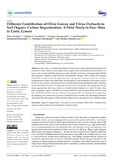Different Contribution of Olive Groves and Citrus Orchards to Soil Organic Carbon Sequestration: A Field Study in Four Sites in Crete, Greece
| dc.contributor.author | Sofoulaki, Eleni | |
| dc.contributor.author | Tzanakakis, Vasileios A. | |
| dc.contributor.author | Giannopoulos, Georgios | |
| dc.contributor.author | Kapellakis, Iosif | |
| dc.contributor.author | Kabourakis, Emmanouil | |
| dc.contributor.author | Chatzistathis, Theocharis | |
| dc.contributor.author | Monokrousos, Nikolaos | |
| dc.date.accessioned | 2023-01-17T13:51:42Z | |
| dc.date.available | 2023-01-17T13:51:42Z | |
| dc.date.issued | 2023-01-12 | |
| dc.identifier.issn | 2071-1050 | |
| dc.identifier.uri | http://hdl.handle.net/11728/12334 | |
| dc.description.abstract | In this work, we evaluated the effects of cultivation practices and sites (representing four locations in Crete, Greece) on soil organic carbon sequestration in established citrus orchards, olive groves, and uncultivated fields (used as a control). Soil pH, soil texture, soil organic matter (SOM), Permanganate Oxidizable Carbon (POXC), Total Kjeldahl Nitrogen (TKN), Carbon and Nitrogen ratio (C:N), as well as soil CO2 respiration rates, and specific enzymes’ activity (i.e., N-Acetyl Glutamate (NAG), Beta Glucosidase (BG), Dehydrogenase) were determined in the upper soil layer (0–20 cm). It was shown that citrus and olive orchards under the South Mediterranean conditions could substantially increase C storage in the soil. However, soils planted with orange trees showed lower capacity than olive trees, which was related to litter chemistry (i.e., leaf C:N ratio). Sites had no significant impact on SOM. In our study, SOM had a positive relationship with TKN (and less with POXC) and the C:N ratio of the tree crop species litter. Our findings have implications for designing soil conservation practices in Mediterranean conditions and developing initiatives describing achievable targets of SOM restoration depending on soil properties and cropping systems. | en_UK |
| dc.language.iso | en | en_UK |
| dc.publisher | MDPI | en_UK |
| dc.relation.ispartofseries | Sustainability;vol. 15, issue 2, 2023 | |
| dc.rights | © 2023 by the authors. Licensee MDPI, Basel, Switzerland. This article is an open access article distributed under the terms and conditions of the Creative Commons Attribution (CC BY) license (https:// creativecommons.org/licenses/by/ 4.0/). | en_UK |
| dc.rights.uri | http://creativecommons.org/licenses/by-nc-nd/4.0/ | en_UK |
| dc.subject | Research Subject Categories::FORESTRY, AGRICULTURAL SCIENCES and LANDSCAPE PLANNING | en_UK |
| dc.subject | organic C sequestration | en_UK |
| dc.subject | olive groves | en_UK |
| dc.subject | citrus orchards | en_UK |
| dc.subject | SOM | en_UK |
| dc.subject | POXC | en_UK |
| dc.subject | Mediterranean agroecosystems | en_UK |
| dc.subject | adaptation and mitigation of climate change | en_UK |
| dc.title | Different Contribution of Olive Groves and Citrus Orchards to Soil Organic Carbon Sequestration: A Field Study in Four Sites in Crete, Greece | en_UK |
| dc.type | Article | en_UK |
| dc.doi | https://doi.org/10.3390/su15021477 | en_UK |
Files in this item
This item appears in the following Collection(s)
-
Articles83
Άρθρα
Except where otherwise noted, this item's license is described as © 2023 by the authors. Licensee MDPI, Basel, Switzerland. This article is an open access article distributed under the terms and conditions of the Creative Commons Attribution (CC BY) license (https:// creativecommons.org/licenses/by/ 4.0/).


